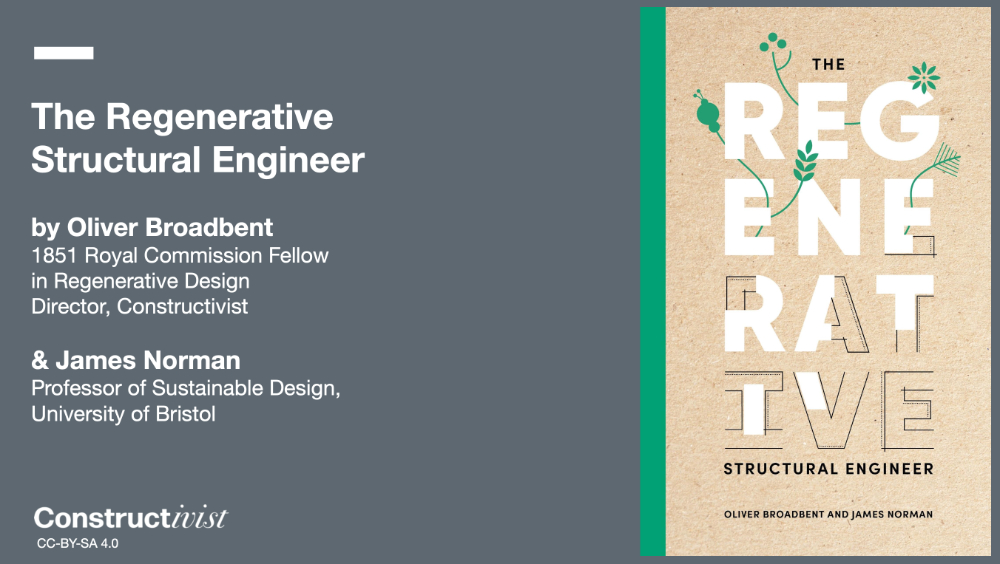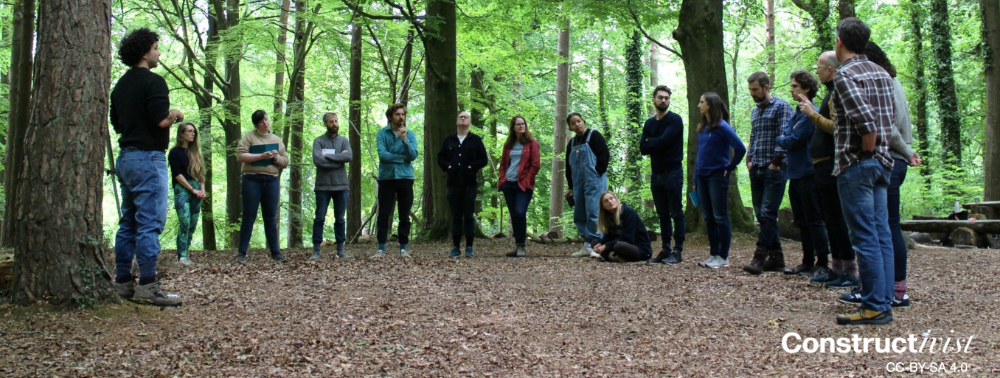The regenerative structural engineer
[edit] Engineers call for the design of buildings, towns and cities that will repair the natural world
We must move from an agenda of “do less harm” to one of “do more good”.
An impassioned appeal for a profound transformation in the global built environment sector to take a more radical approach to design and construction is made by leading regenerative thinkers and engineers Oliver Broadbent and James Norman in their launched January 2024.
The regenerative structural engineer, published by the Institution of Structural Engineers (IStructE), is a creative call by the authors for fundamental change that challenges engineers and the wider built environment industry to think and design differently - to do more good.
While detailing technical issues, the book is also clear, accessible and written with the non-expert in mind, using UK and global case studies to draw on a number of existing projects and practices. These all illustrate how a regenerative transition can be achieved in a way that feels plausible and deliverable.
The book takes a deep dive into broad themes of holistic sustainability, community co-creation, and their links to design and construction. The content confronts the factors that have limited regenerative progress so far:
- the notion of continuous economic growth;
- the problem of aiming to just “do less harm”, and missing that target;
- the issue of focussing mainly on carbon instead of addressing the wider system;
- and the failure to consider how the damage already done to the planet’s life support systems can be healed.
James Norman, Professor of Sustainable Design at the University of Bristol, says: “These factors point to the urgent need for a new design approach so that the impact of our work across the built environment increases the health of our planet and communities.”
Oliver Broadbent, 1851 Fellow in Regenerative Design, adds: “The aim of regenerative design is for human and living systems to survive, thrive and co-evolve. Our book advocates adopting a systems thinking approach to change, one that takes a holistic approach to design and construction. We illustrate this using case studies, diagrams and metaphors, making this complex subject accessible to the reader.”
The authors explain: “Systems thinking enables us to see the impact of our design choices on the wider construction industry, and in turn on the wider ecosystem. It’s an interconnected approach to address a huge concept. It helps us to organise for change, enabling how we transition from where we are to the future we choose."
“Observation is core to this change, really looking at what we’re doing. This moves us from viewing the living world as a natural backdrop to our work, instead seeing it as a dynamic, evolving system which our design is deeply connected to. Once we understand these relationships, we can not only create better designs, we can work to change the system to enable others to do so too.”
The book explains the role of the structural engineer in this regenerative approach - one that depends on collaboration and challenging existing ways of thinking.
Michael Pawlyn, co-author of ‘Flourish: Design Paradigms for Our Planetary Emergency’, and co-founder of Architects Declare says of the book: “The authors have done the reader a great service by digesting a huge amount of material -particularly on systems thinking - and synthesising it into a coherent case.”
The authors say: “We want to move the construction industry further away from harmful practices and bring it much closer to a system that drives positive outcomes in every part of operations.”
In the book’s epilogue, James describes a possible future (2050) where he currently lives, and how homes and streets will change. It gathers all the different themes of the book to paint a detailed and evocative picture of the future.
James concludes: “This demonstrates why we still have hope, just how much work we have to do and why we need to start now if we are going to get there in the next 26 years. To practitioners today it will both challenge them and give a fresh impetus and direction for the work that needs to be done.”
The regenerative structural engineer is available from IStructE’s website: https://www.istructe.org/resources/guidance/the-regenerative-structural-engineer/
This article was issued via Press Release as 'Engineers call for the design of buildings, towns and cities that will repair the natural world' supplied April 18 by Alexie Sommer: Design, Communication, Strategy & Impact. The regenerative structural engineer, was written by Oliver Broadbent and James Norman and published by the Institution of Structural Engineers (IStructE).
[edit] Related articles on Designing Buildings
- Architects Declare.
- Biocement.
- Biomimicry.
- CIBSE Case Study: Bosco Verticale.
- Cradle-to-cradle.
- Cradle to cradle product registry system.
- Leadership in Energy and Environmental Design LEED.
- Rapidly renewable content.
- Re-establish human relationships with the natural world.
- Regenerative design.
- Sustainability in building design and construction
- Vertical Forest
- Wood and the Circular Economy
Featured articles and news
A change to adoptive architecture
Effects of global weather warming on architectural detailing, material choice and human interaction.
How big is the problem and what can we do to mitigate the effects?
Overheating guidance and tools for building designers
A number of cool guides to help with the heat.
The UK's Modern Industrial Strategy: A 10 year plan
Previous consultation criticism, current key elements and general support with some persisting reservations.
Building Safety Regulator reforms
New roles, new staff and a new fast track service pave the way for a single construction regulator.
Architectural Technologist CPDs and Communications
CIAT CPD… and how you can do it!
Cooling centres and cool spaces
Managing extreme heat in cities by directing the public to places for heat stress relief and water sources.
Winter gardens: A brief history and warm variations
Extending the season with glass in different forms and terms.
Restoring Great Yarmouth's Winter Gardens
Transforming one of the least sustainable constructions imaginable.
Construction Skills Mission Board launch sector drive
Newly formed government and industry collaboration set strategy for recruiting an additional 100,000 construction workers a year.
New Architects Code comes into effect in September 2025
ARB Architects Code of Conduct and Practice available with ongoing consultation regarding guidance.
Welsh Skills Body (Medr) launches ambitious plan
The new skills body brings together funding and regulation of tertiary education and research for the devolved nation.
Paul Gandy FCIOB announced as next CIOB President
Former Tilbury Douglas CEO takes helm.
UK Infrastructure: A 10 Year Strategy. In brief with reactions
With the National Infrastructure and Service Transformation Authority (NISTA).
Ebenezer Howard: inventor of the garden city. Book review.
Airtightness Topic Guide BSRIA TG 27/2025
Explaining the basics of airtightness, what it is, why it's important, when it's required and how it's carried out.
























